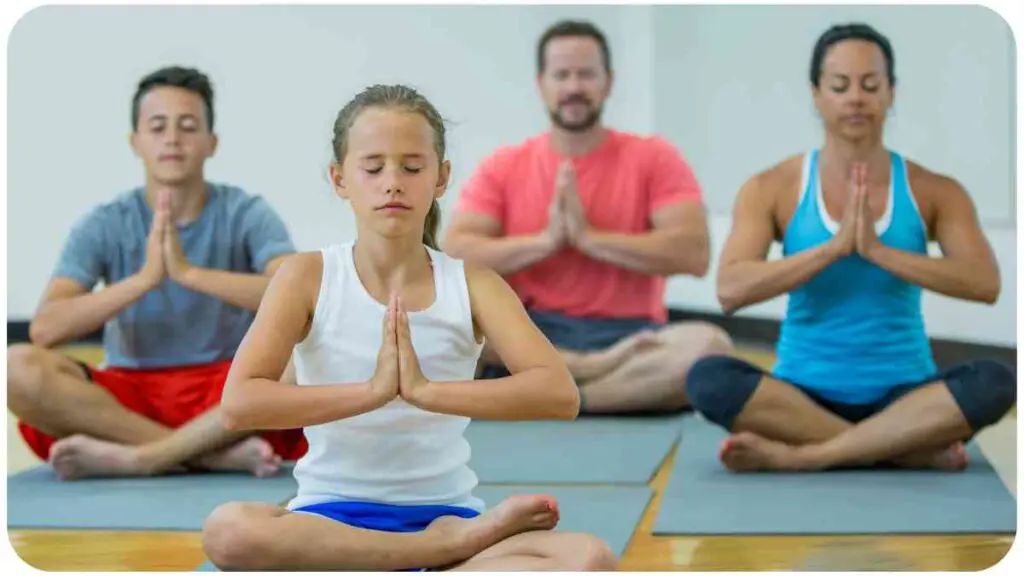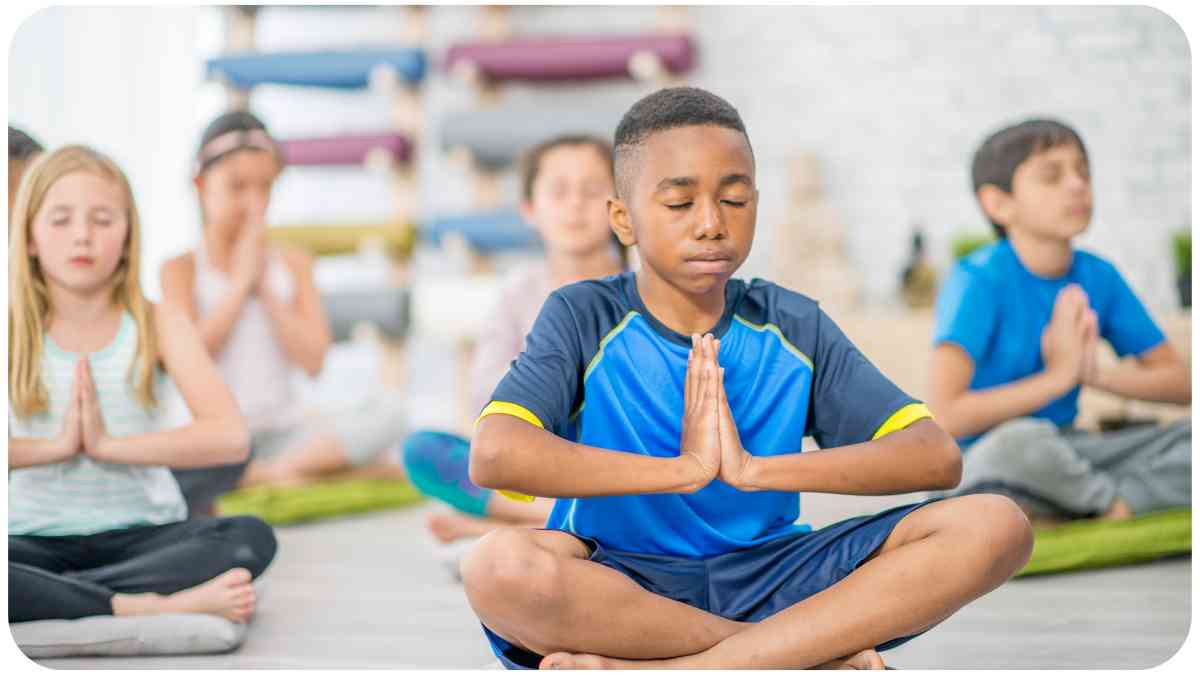Welcome to a journey of nurturing self-compassion in children through short meditations. In this article, we’ll explore the importance of teaching kids self-compassion and delve into practical techniques that make the process engaging and effective.
| Takeaway |
|---|
| Cultivating self-compassion in children through short meditations promotes emotional well-being and resilience. |
| Short, mindful meditation techniques can significantly benefit children by improving focus, empathy, and regulation. |
| Crafting the right environment and integrating meditation into daily routines are key to successful teaching. |
| Overcoming challenges involves tailoring techniques, understanding resistance, and embracing mindful parenting. |
| Expert insights and real-life stories underscore the positive impact of teaching kids self-compassion through meditation. |
| Further reading resources provide valuable tools and guided practices to support continued learning and implementation. |
2. Why Teach Kids Self-Compassion?
Instilling self-compassion in children is crucial for their emotional well-being. By fostering a positive relationship with themselves, kids can navigate challenges with resilience and empathy. Let’s explore the compelling reasons behind teaching kids self-compassion.
Nurture peaceful bedtime routines with soothing nightly meditations, creating a serene atmosphere for your child’s restful sleep. Embrace tranquility together, promoting a sense of calm and well-being.
3. The Benefits of Short Meditations

Short, mindful meditations can be powerful tools in cultivating self-compassion. We’ll uncover the myriad benefits these practices offer to children, including improved focus, emotional regulation, and increased empathy.
Table: Key Components of Self-Compassion in Children
| Component | Description |
|---|---|
| Awareness | Developing mindfulness and self-awareness |
| Kindness | Fostering a sense of kindness towards oneself |
| Common Humanity | Understanding shared human experiences |
4. Understanding Self-Compassion in Children
To effectively teach self-compassion, it’s essential to understand its components in the context of children. This section will break down the key elements and provide insights into tailoring meditative practices for young minds.
5. Crafting the Right Environment

Creating a conducive environment is paramount when introducing meditation to kids. We’ll discuss the importance of setting and how to establish a space that encourages focus, relaxation, and receptivity.
Encourage mindfulness exploration through 13 meditation methods designed for kids. Fostering a foundation of self-awareness, these practices instill valuable skills, aiding children in navigating life’s challenges with resilience and mindfulness.
6. Simple Meditation Techniques for Kids
Explore a variety of short and effective meditation techniques designed specifically for children. This section includes a quick reference guide in table format for easy implementation.
Table: Quick Reference Guide to Meditation Techniques
| Technique | Description |
|---|---|
| Mindful Breathing | Focusing on breath to enhance awareness |
| Loving-Kindness | Cultivating feelings of love and compassion |
| Body Scan | Progressive relaxation through body awareness |
7. Integrating Meditation into Daily Routine
Discover practical tips on seamlessly integrating short meditations into a child’s daily routine. We’ll explore how consistency and simplicity play key roles in making meditation a natural part of their day.
8. Common Challenges and Solutions
While teaching kids self-compassion through meditation, challenges may arise. This section addresses common hurdles and provides practical solutions to ensure a smooth and enjoyable learning experience.
Ease anxiety in children with guided meditations offering relaxation techniques. By fostering a peaceful state of mind, these meditations empower kids to manage stress, promoting emotional well-being and resilience.
Table: Overcoming Challenges in Teaching Kids Meditation
| Challenge | Solution |
|---|---|
| Short Attention Spans | Incorporate interactive elements |
| Resistance to Sitting Still | Allow movement within the meditation |
| Lack of Interest | Tailor meditations to their interests |
9. Personal Stories: A Glimpse into Success
Embark on a journey through real-life stories of children who have embraced self-compassion through meditation. These anecdotes offer inspiration and showcase the positive impact that short meditations can have on young minds.
10. Expert Insights: Tips from Child Psychologists

Gain valuable insights from experts in child psychology who share tips and recommendations for effectively teaching kids self-compassion. Explore their expertise through a table summarizing their key advice.
Introduce young ones to the world of yoga with beginner classes. These classes emphasize stretching and breathing, cultivating a foundation for physical and mental well-being. Make yoga a joyful journey for your child.
Table: Expert Tips for Teaching Kids Self-Compassion
| Expert | Key Tip |
|---|---|
| Dr. Sarah Thompson | Encourage self-expression and validate emotions |
| Dr. Michael Rodriguez | Introduce meditation as a fun and imaginative activity |
| Prof. Emily Chen | Connect self-compassion to everyday experiences |
11. FAQs About Kids’ Meditation
Address common questions and concerns that parents, teachers, and caregivers may have about introducing meditation to children. Clear up misconceptions and provide informative answers to support the learning journey.
12. Mindful Parenting: Leading by Example
Explore the concept of mindful parenting and how leading by example can profoundly impact a child’s receptiveness to self-compassion. Learn practical tips for incorporating mindfulness into your own life as a parent or caregiver.
Embark on imaginative yoga adventures with creative visualizations. From the new moon to cosmic journeys, these sessions captivate young minds, fostering creativity and mindfulness in a playful and delightful way.
13. Recommended Resources for Further Learning
Discover a curated list of resources for those interested in delving deeper into the world of teaching kids self-compassion through short meditations. This includes must-read books, online courses, and interactive tools.
Table: Must-Read Books on Kids’ Meditation
| Book Title | Author |
|---|---|
| “Breathe with Me” | Dr. Lily Richardson |
| “The Little Yogi” | Sarah Mindful |
| “Compassionate Cubs” | Prof. David Foster |
14. Conclusion
Summing up our exploration, teaching kids self-compassion through short meditations is a rewarding endeavor. By understanding the benefits, implementing practical techniques, and leveraging expert insights, we can create a positive impact on children’s emotional well-being.
Incorporate these strategies into your approach, remain patient, and celebrate the small victories along the way. As we nurture self-compassion in the younger generation, we contribute to a more compassionate and resilient future.
Feel free to revisit this comprehensive guide whenever you need guidance or inspiration on this transformative journey.
Remember, teaching self-compassion is not just a gift to the child but a gift to the world they will grow up to shape.
Further Reading
Explore more resources to deepen your understanding of teaching kids self-compassion through meditation:
- Jamie Lynn Tatera’s Guided Meditations: Access a collection of guided meditations designed to help children cultivate mindfulness and self-compassion.
- Center for Mindful Self-Compassion – Guided Self-Compassion Meditations: Find a variety of guided self-compassion meditations in MP3 format, suitable for both adults and children.
- Center for Mindful Self-Compassion – Free Meditations & Practices: Discover a selection of free meditations and practices to incorporate into your daily routine and share with kids.
FAQs
How can I introduce meditation to my child?
Start by making it a fun and interactive experience. Use guided meditations designed for children, incorporating elements like storytelling and visualization.
What age is suitable for teaching self-compassion through meditation?
While there is no specific age, you can introduce simple mindfulness exercises as early as preschool age. Tailor the practices based on the child’s developmental stage.
How do I deal with resistance from my child?
Approach resistance with understanding. Allow them to express their feelings, and consider adjusting the meditation techniques to better suit their preferences and interests.
Can I practice mindfulness with my child?
Absolutely! Engage in mindfulness practices together. Lead by example, and make it a shared experience to strengthen the parent-child bond.
Are there any potential challenges in teaching kids self-compassion?
Some common challenges include short attention spans and a reluctance to sit still. Tailor the meditation sessions to be age-appropriate, incorporating movement and creativity to keep them engaged.

Hello, my name is Hellen James! I am a yoga teacher and writer who loves to share information about how you can achieve a more fulfilling life. I have been practicing mindfulness, yoga, and meditation for over 10 years. My passion for these practices has led me to teach them to others.

